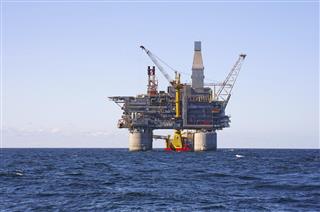
Oil drilling or extracting oil is expected to boost the economic growth by reducing import of foreign oil; however, it does pose a negative impact on the environment.
As we all know, crude oil is fossil fuel, found deep under the Earth’s surface, trapped between the rock layers. It is formed from the remains of plants and animals in the seas, after being subjected to extreme high temperature and pressure conditions for thousands of years.
Pros of Oil Drilling
- Oil drilling should be allowed in order to lower the fuel prices that will play a significant role in the economic growth of the country. If it is banned in a particular region, it leads to a situation, whereby the dependence on other countries for oil increases. In simpler words, oil import increases and consequently, it affects the overall country’s income.
- Another benefit is that the process of drilling itself and development of land after the extraction will help in engaging people, thus creating jobs for hundreds of citizens.
- With the development of new technologies, it has been stated that drilling can be done without damaging the environment and disturbing the plant and animal habitat. Overall, oil drilling will improve the economy of the people and the country as a whole.
Cons of Oil Drilling
- One of the major negative impacts of oil drilling is the environmental issue. If oil production rate is higher, then there will be more usage, thus generating more greenhouse gases.
- Moreover, it is obvious that the drilling process will disturb the organisms (plants and animals) living in those areas.
- The success rate of oil drilling is also very low, meaning that it takes lots of time and the outcome is unpredictable.
- Another prime issue is offshore drilling; starting from locating to the drilling process, it disturbs the sea environment. While locating oil, the seismic waves and the associated sound affects the sea organisms, and the last debate is about oil spillage in the seas.
The pros and cons of oil drilling has been a debatable topic since a long time. Some are of the opinion that since oil is a basic necessity that is utilized for carrying out our day-to-day activities, why not drill oil to meet our requirements, other than relying on foreign oil. This will bring about a reduction in the price of oil that ultimately affects all of us. On the contrary, the environmentalists oppose the idea stating that oil drilling increases environmental pollution and disturbs the biodiversity of that area. Besides this, there is no surety about its productivity. Last but not the least, offshore drilling for oil is not free of accidental cases.
Crude Oil: Formation
Formation of crude oil requires millions of years. As organisms die, they settle at the sea bottom, which are then covered by layers of mud and sediment depositions. The anaerobic microorganisms act slowly on the dead plants and animals in the absence of oxygen, forming a carbon-rich organic layer. This organic layer along with the sediments is called the source rock (fine-grained shale). Due to the overlying sedimentary layers, the organic layer is subjected to elevated temperature and pressure. Because of this, distillation of organic material occurs, leading to the formation of crude oil and natural gas. The resulting crude oil is accumulated in porous reservoir rocks that can either be limestone or sandstone. These reservoir rocks are then trapped in compact and impermeable rocks (without pores) called the cap rocks.
Oil Drilling: How it Works?
Oil drilling is the process of extracting crude oil by drilling through the cap rock. In the extraction process, the most challenging part is locating crude oil, since it is found under the cap rocks that can be several miles thick. So, geologists need to study the surface material, source rock, and reservoir rock as a preliminary step. They use certain techniques to find a prospective oil trap, of which the most common is seismology. According to this method, shock waves are sent to the land surface or sea surface, to estimate the time taken by the waves to return. By comparing the travel times of known rock layers, geologists determine and predict the layers that could be present in the particular region. Seismology is found to have a 10 percent success rate of discovering oil sites. Other approaches for finding oil are satellite imaging, shallow drilling, sniffers (electronic noses to smell hydrocarbons), magnetometers, and gravity meters.
The conclusion of the oil drilling issue is; choosing between the economic growth of the country and reducing environmental consequences. Since, oil is a non-renewable source of energy, why not save these oil reserves for future generations by looking out for alternative energy sources like solar energy, hydroelectric powers, and wind energy. This way, we can put an end to environmental issues and shortage of energy sources.







